|
There's
no doubt that Doctor Who is as much an English institution
as fish and chips and inclement weather. Its influence has
reflected on many generations, but what has influenced Doctor
Who? Like James Bond it needs to conform to certain
strict criteria. There can be next to no character progression,
except perhaps to recall and learn from past events. The Doctor's
reaction to new and even hazardous situations is childlike
wonder or, on occasion, religious reverence.
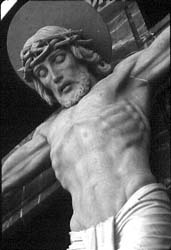 |
Ah,
now there's something... Passive religion has had a profound,
though referred, effect on the programme's history. Let's
begin with Time Lord society, which appears to be based heavily
on ceremony. Elaborate robes, hierarchically divided according
to school-house-like chapters and designations, along with
regalia and an air of serene superiority are surely connections
to the church. Having discovered a manner in which to traverse
time, they now see themselves as lords over it. They have
strict laws of time and a policy of non-intervention in the
affairs of other societies, which could be said to be a Godlike
wisdom of allowing people to learn from their own mistakes
(though they think nothing of unleashing the odd bolt of lightening:
removing someone from existence itself, forcibly regenerating
the Doctor, or even the attempted termination of him to save
themselves).
The Black Scrolls and The Ancient Law of Gallifrey
contain "forbidden knowledge" of the dark times; forbidden
because no society wants to remember its failures. So they
exist as a reminder to only the elite, like the downbeat sections
of The Bible which seek to investigate the dark side of the
human psyche. In fact, it was rumoured at one time that an
earlier form of what became known as The Bible existed in
the Vatican. It was said to conflict drastically with the
later writings and contain such horrific events that it was
not fit for the world, religious or otherwise, to behold.
Everyone likes to be frightened, say the experts; it's good
for the soul. The horror element is an integral part of the
Doctor Who mythos, but like all monsters they are only
original reflections of the legends of ancient cultures and
perhaps one of the oldest horror books of all (whether it
be truth or fiction), Revelations, from The New Testament.
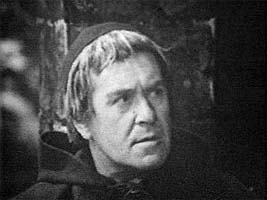 |
Aside
from the Doctor, there are a few other so-called renegade
Time Lords. One such example is the Monk, played by Peter
Butterworth in two William Hartnell stories, The Time Meddler
and The Daleks' Masterplan. As the character's motives
are far from religious it can only be assumed the robes were
worn to enable him to more readily infiltrate and manipulate
the peoples of religious societies. His robes of false-office
allow him to come and go, unchallenged, from an empty monastery.
Such is the church's status in this time-line that he is actively
aided by the locals.
Before
the backdrop of Time Lord society had been established on
screen, the War Chief was seen as a reckless, argumentative
antithesis of the official Time Lords themselves, who serenely
acted as self-appointed judge, jury and executioner, even
though they were said to have that non- intervention policy.
If a classroom full of obedient zombies has one individual
who is prepared to question what is being taught, then is
that student viewed as being a disruptive influence or an
original thinker? Clearly, we are steered towards believing
the former of the War Chief - for good reason - and the latter
for the Doctor, although they are somewhat similar in their
unorthodox methods and treated as such by the self-important
Time Lords. It's indicative of the power the church once commanded,
even to the detriment of royalty, and the influence from the
past it retains to a lesser extent today.
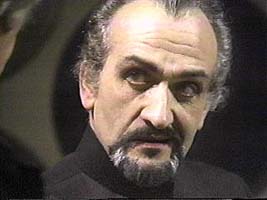 |
When
the Master entered the picture only a couple of years later,
his mannerisms were gentlemanly in all but his aspirations.
Aside from the formal exterior lending greater effect to his
inner intent, it was also a throwback to that strict formal
society. Witness the third Doctor's harbinger of doom in Terror
of the Autons, looking for all the world like a city toff.
In fact, Hartnell's and Pertwee's portrayals are much more
in keeping with that formal bearing: the air of no-nonsense
authority over pompous bureaucracy being tantamount to the
reason why the Doctor escaped the confines of Gallifrey in
the first place. Class is the obvious link to western culture
religions here; even a lowly priest in the middle-ages enjoyed
certain courtesies and privileges.
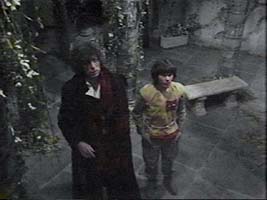 |
The
interior of the Doctor's TARDIS in the series is generally
clean and brightly lit, almost to the point of purveying a
sterile atmosphere. Its inferred vastness is cathedral-like,
as evidenced in the fourth Doctor story, The Masque of
Mandragora, wherein Sarah Jane catches a glimpse of the
boot cupboard. This cathedral architecture is prominent in
the Paul McGann TV movie, even to the point of stained-glass
windows. The central column of the time rotor descending from
the high ceiling exaggerates the grandness, as does the plainly
monastic look to the TARDIS library. Temporal grace, a particularly
religious term, prevents weapons being discharged inside.
This reflects from the church's preaching
of pacifism, which is ironic as more wars through history
have raged in the name of religion than anything else, barring
perhaps land itself. There
are cloisters, as evidenced in Tom Baker's final story, Logopolis,
and a cloister bell which chimes as a portent of doom in the
same manner as a church bell once signalled a journey to the
gallows. The TARDIS can travel to any point in time and space,
which in my book is the closest a person can come to omnipotence;
to travel to different time periods and not be affected by
its passage you must surely have to be outside of time itself,
a godlike position.
Although
reluctant to open a veritable can of worms by relating a popular
family-viewing televisual experience to the teachings of the
Bible, can there be any greater compliment than to compare
such a successful and workable premise and expanding format
to the greatest story ever told?
Most
significantly, let's turn to the character of the Doctor himself.
The most remarkable trait is his Time Lord ability to regenerate
his dying body (reincarnation, anybody?). Twelve regenerations
(that's thirteen bodies) are possible, and whilst not being
true immortality, a careful Time Lord could conceivably live
for thousands of years. The seventh Doctor was over 950 years
old, and you could hardly call him careful!
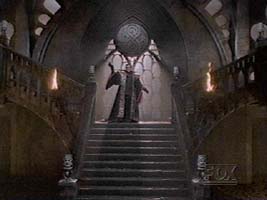 |
The
Doctor always sides with the underdog against oppression in
the face of great adversity. This is exactly what Jesus Christ
achieved, and like Jesus the Doctor has the charisma and conviction
to walk into a situation and instantly command attention,
gaining converts to his pleas for justice - the former under
constant threat from the military might of the Roman empire,
and the latter amidst mad scientists and alien invaders. A
first Doctor historical adventure was set at the time of Roman
dominance. Although no one noted it at the time, the generally
light- hearted direction of the story retrospectively prevented
any comparisons being made (except by me, of course!). Admittedly
Roman influence was wide-spread and spanned many years, but
it's worth pointing out nonetheless. And talking of Romans,
the paragon of "When in Rome, do as the Romans do" doesn't
appear to be a code of conduct as far as the Doctor is concerned.
Time Lord arrogance again? Self-preservation in the face of
forced sacrifice to some unknown deity is one thing, but we
have witnessed many pagan-like rituals being played out in
Doctor Who, and our hero always attempts to avert the
so-called "atrocities" rather than accepting that this is
their everyday way of life... their beliefs. It is the age-old
trap of one religious order trying to stamp out another, rather
than accepting a difference of opinion and getting on with
life.
In the same manner that some sceptics might write off miracles
as illusion or technological wizardry in the face of anachronism,
the Doctor has managed many death-defying manoeuvres. Jesus
was seen to have died on the cross, and yet pulled off the
greatest escape from a sealed tomb, to be seen alive again
later by witnesses. The Doctor has often seen to be dead,
only to be saved by his increasingly astonishing physiognomy:
two hearts, a respiratory by-pass system, the ability to lower
his heartbeats considerably and even enter a self-induced
healing coma. As for the disappearing act, well, TARDISes
are supposed to contain a chameleon circuit enabling them
to blend in with their surroundings, thereby rendering them
invisible to the untrained eye. It's almost as if Doctor Who
creator Sydney Newman and his subsequent associates sought
to logically rationalise those historical events in terms
of believable fiction. However, it would an outrageous conceit
for anyone to claim that this was all intended from the original
concept; particularly because background detailing has been
added over the years - often for the sake of convenience -
to flesh-out the central character and situations as much
as it is possible within the constricting parameters.
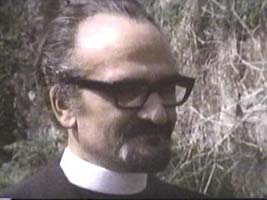 |
Jesus
had his disciples, and the Doctor's companions are not too
dissimilar in their motives. No matter how they come to be
TARDIS crew members they soon realise the Doctor always struggles
to do the right thing (not always the lawful thing) and will
not turn his back on a situation where he can make a difference.
In fact, the Doctor will protect his travelling companions
with his life, never hesitating to make decisions of self-sacrifice
when warranted. Jesus demonstrated the greatest sacrifice
of them all; so too the Doctor. After all, the act has the
same importance whether it be on behalf of one or many. Perhaps
the best example of this is when the fifth Doctor and Peri
contract the fatal disease Spectrox Toxaemia. The Doctor struggles
in a weakened condition to the lower levels of the caves to
obtain the bat's milk antidote, but only recovers enough for
one person; Peri is his first consideration. For the fifth
time the Doctor regenerates.
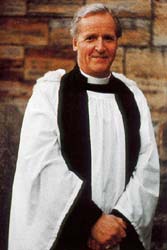 |
However,
there was one very different companion. Turlough was the Judas
Iscariot of the Doctor Who world, betraying the Doctor's trust
and in this case even attempting to kill him several times.
Turlough was found to be under the influence of an entity
known as the Black Guardian (a case of the Devil made me do
it!). This neatly brings me back to the Master, if we can
return to his shenanigans for a moment. This evil renegade
character was originally brought to the programme as a Moriarty
to the Doctor's Sherlock Holmes, but he is better suited as
a Satan to the Doctor's messiah. In the same way that the
Fallen Angel was banished from Heaven, the home of Jesus,
the Master is a Time Lord and also comes from Gallifrey, making
him conceivably the ultimate living nemesis. He is a perfect
opposite to the Doctor, and like the sixth Doctor's adversary
the Valeyard, epitomises the dark side of us all.
So
there you have it, reasonably brief and to the point; the
influences (purposeful or not) are there if you look in the
right places. Doctor Who borrows from only one place for its
theme, making it one of the most original, flexible and therefore
enduring ideas ever devised for TV family viewing. In the
face of increasing adversity over the years, curiously including
dissention in the ranks - or, perhaps, more accurately described
as "leading from the back" - it is truly remarkable that Doctor
Who has thrived for so many years, albeit nowadays in so many
other forms. A miracle? Perhaps. Now all we have to do is
pray for its TV return!
Return
to...

|